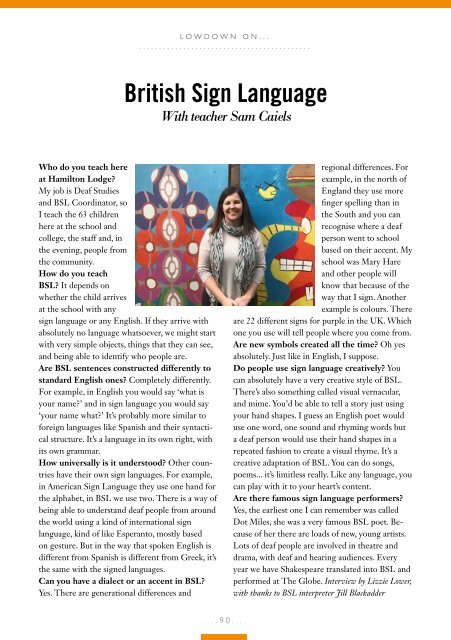Viva Brighton Issue #62 April 2018
Create successful ePaper yourself
Turn your PDF publications into a flip-book with our unique Google optimized e-Paper software.
LOWDOWN ON...<br />
...........................................<br />
British Sign Language<br />
With teacher Sam Caiels<br />
Who do you teach here<br />
at Hamilton Lodge?<br />
My job is Deaf Studies<br />
and BSL Coordinator, so<br />
I teach the 63 children<br />
here at the school and<br />
college, the staff and, in<br />
the evening, people from<br />
the community.<br />
How do you teach<br />
BSL? It depends on<br />
whether the child arrives<br />
at the school with any<br />
sign language or any English. If they arrive with<br />
absolutely no language whatsoever, we might start<br />
with very simple objects, things that they can see,<br />
and being able to identify who people are.<br />
Are BSL sentences constructed differently to<br />
standard English ones? Completely differently.<br />
For example, in English you would say ‘what is<br />
your name?’ and in sign language you would say<br />
‘your name what?’ It’s probably more similar to<br />
foreign languages like Spanish and their syntactical<br />
structure. It’s a language in its own right, with<br />
its own grammar.<br />
How universally is it understood? Other countries<br />
have their own sign languages. For example,<br />
in American Sign Language they use one hand for<br />
the alphabet, in BSL we use two. There is a way of<br />
being able to understand deaf people from around<br />
the world using a kind of international sign<br />
language, kind of like Esperanto, mostly based<br />
on gesture. But in the way that spoken English is<br />
different from Spanish is different from Greek, it’s<br />
the same with the signed languages.<br />
Can you have a dialect or an accent in BSL?<br />
Yes. There are generational differences and<br />
regional differences. For<br />
example, in the north of<br />
England they use more<br />
finger spelling than in<br />
the South and you can<br />
recognise where a deaf<br />
person went to school<br />
based on their accent. My<br />
school was Mary Hare<br />
and other people will<br />
know that because of the<br />
way that I sign. Another<br />
example is colours. There<br />
are 22 different signs for purple in the UK. Which<br />
one you use will tell people where you come from.<br />
Are new symbols created all the time? Oh yes<br />
absolutely. Just like in English, I suppose.<br />
Do people use sign language creatively? You<br />
can absolutely have a very creative style of BSL.<br />
There’s also something called visual vernacular,<br />
and mime. You’d be able to tell a story just using<br />
your hand shapes. I guess an English poet would<br />
use one word, one sound and rhyming words but<br />
a deaf person would use their hand shapes in a<br />
repeated fashion to create a visual rhyme. It’s a<br />
creative adaptation of BSL. You can do songs,<br />
poems... it’s limitless really. Like any language, you<br />
can play with it to your heart’s content.<br />
Are there famous sign language performers?<br />
Yes, the earliest one I can remember was called<br />
Dot Miles, she was a very famous BSL poet. Because<br />
of her there are loads of new, young artists.<br />
Lots of deaf people are involved in theatre and<br />
drama, with deaf and hearing audiences. Every<br />
year we have Shakespeare translated into BSL and<br />
performed at The Globe. Interview by Lizzie Lower,<br />
with thanks to BSL interpreter Jill Blackadder<br />
....90....


















